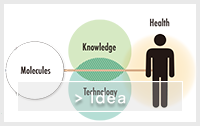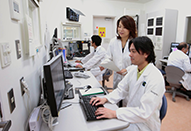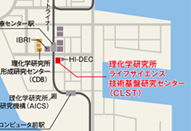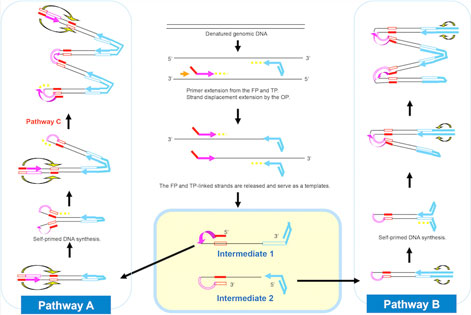Technologies of CLST
SmartAmp: Smart Amplification Process
SmartAmp® is an isothermal DNA amplification technology which was jointly developed by RIKEN and DNAFORM.
The Smart Amplification process (SmartAmp) method uses isothermal nucleic acid amplification technology and employs a single reaction temperature (60-67ºC), which translates into simple and less expensive instrumentation (Mitani, 2007). SmartAmp method facilitates not only highly sensitive detection of target DNA such as infectious diseases, but also discrimination of genetic polymorphisms or mutations in target genes within 30-45 min, without tangled DNA isolation process.
The entire DNA amplification process in the SmartAmp method requires four primers: the turnback primer (TP), boost primer (BP), forward primer (FP), and outer primers (OP) (Figure 1A). Comparing with PCR, SmartAmp produces continuous long double-stranded DNA concatenated target sequences as the amplified products by self-annealing and priming of 3’-terminal end of products based on TP and FP sequences. Additionally, DNA polymerase used SmatAmp has strand-displacement activity, and the polymerase synthesizes newly DNA strand with unthreading of double-stranded DNA. Therefore in SmartAmp reaction, each primer easily anneals to target DNA without denaturing of DNA by high-temperature, and DNA synthesis continuously occurs in isothermal condition (Figure 1B). For precise design of primer sets for the reaction, we have developed algorithms specific to SmartAmp primer design (Kimura et al., 2011). Primers are selected based on those algorithms that consider free energy, probability of base-pairing, product size range, optimal melting temperature, and product size range.
Since SmartAmp method is carried out at 60-67ºC, it is able to combine a reverse-transcipase (RT)-reaction and SmartAmp-based DNA amplification reaction in one step, and the method is also available for genomic RNA detection. As example using this one-step reaction for clinical needs, we constructed highly sensitive detection kit of influenza A/B virus. The result of comparing with conventional method such as immunochromatography, our established RT-SmartAmp kit achieved 100 times higher sensitivity (Figure 2).
A) Example of amplification curve
B) Concordance of results between SmartAmp and immunochromatography methods in clinical for influenza A/B detection
Figure 2 . Amplification results of influenza detection.

















